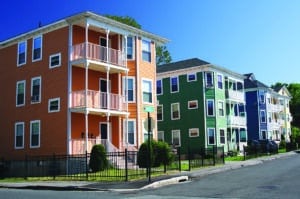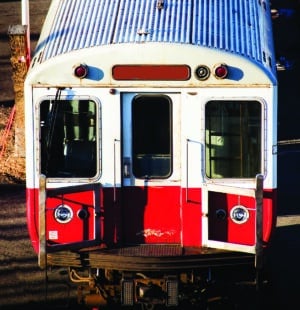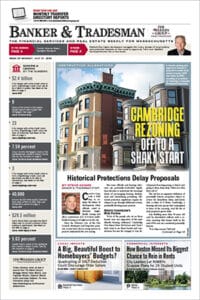Massachusetts communities have their marching orders for complying with the state’s new Housing Choice law designed to spur suburban multifamily development, and housing advocates say it’s an aggressive approach that addresses longstanding barriers to housing head-on.
The Baker administration laid out the ground rules for how 175 Bay State cities and towns must comply with a new requirement for multifamily zoning, affecting a broad swath of the state from central Massachusetts to Cape Cod and the New Hampshire border.
The proposed regulations – which will take effect following a public comment period that runs through March 31 – appear to support legislators’ goal of generating meaningful transit-oriented development, said Salim Furth, an economist and senior research fellow at George Mason University’s Mercatus Center.
The state set a 50-acre minimum for the new multifamily zoning districts required in the communities served by the MBTA, and warned communities against piecing together districts from small non-contiguous parcels that would be unsuitable for significantly-sized projects.
“Cities won’t be able to scatter their zones [with] one spot here and one spot there, and say they qualify based upon existing buildings. They can’t spot-zone their way to compliance,” Furth said.
Part of the state economic development bill enacted nearly a year ago, the zoning measure was considered a crucial element of breaking through longstanding barriers to multifamily housing production in Massachusetts suburbs. It requires MBTA communities to allow multifamily zoning by-right near train stations and points where bus lines intersect. A 2021 Metropolitan Area Planning Council study estimated would create 31,000 acres worth of development sites in 38 communities that currently have more restrictive zoning.
“We’re impressed with how helpful the targets are for housing production, and that is definitely appropriate to the scale of the problem,” said Timothy Reardon, data services director for Metropolitan Area Planning Council.
But Reardon cautioned that the requirements could create challenges for some communities to find locations that integrate housing into walkable districts.
“Our question is what support will be given to communities to plan for this amount of housing. The guidelines could go a little further to address those issues, because no one wants to create thousands and thousands of units in an auto-dependent development that happens to be near transit,” Reardon said.

About half of all Massachusetts communities are required to enact zoning districts encouraging multifamily development at a density of 15 units per acre – equivalent to a neighborhood of three-deckers.
State Gets Specific About Obligations
The state Department of Housing and Community Development was responsible for translating the law into regulations that address lingering questions: which communities are subject to the new requirements? How big of a zoning district is needed to comply? What density is required near different types of public transit, such as subways, bus stops and commuter rail?
The 50-acre zoning district minimum creates a threshold of 750 units of existing or potential new multifamily units per community, reflecting the density requirement of 15 units per acre. The regulations also clarify that “as-of-right” approvals can be predicted upon a site plan review, which can regulate details of the project design, but not deny it.
Rachel Heller, CEO of the Citizens’ Planning and Housing Organization, said the regulations will be felt even in towns with densely developed areas around their MBTA commuter rail stations.
“What has happened in the last 30 years is a lot of downzoning,” Heller said. “The neighborhoods we love can’t be built anymore.”
Restrictive local zoning controls continue to depress multifamily development in all but a handful of communities including Boston and nearby cities. Housing production still remains well short of the regional goal of 185,000 new units in Greater Boston by 2030 that was sought by a coalition of metro-area mayors in 2016, according to a May report by The Boston Foundation which estimated that current development activity is only proceeding at half of the levels needed to meet the 185,000-unit goal.
Even Boston’s decade-long multifamily boom appears to be waning, as apartment and condo developers struggle to outbid life science developers for sites. In 2021, the Boston Planning & Development Agency approved 6,643 new residential units, down 34 percent from the 10,000-plus units approved the previous year.
State Signs Off on Sites
Communities have been seeking advice from EOHED throughout the year on potential locations for the new districts, according to documents obtained by Banker & Tradesman under a public records request. EOCD issued advisory opinions that endorsed sites in Chelmsford, Groton, Marlborough and Wareham.
In Chelmsford, Trammell Crow Residential is proposing a 400-unit apartment complex at the 34-acre former University of Massachusetts-Lowell west campus. The 121-acre Marlborough site on Campus Drive is the site of a proposed zoning amendment by Boston-based Greatland Realty Partners, which would allow up to 100 housing units in an expansion of The Campus at Marlborough office park.
Only a request by the Westford planning board to designate a 43-acre parcel off Tyngsboro Road received a negative recommendation. Clark Property Development has proposed 95 units of senior housing on the property, which is located 8 miles from the nearest commuter rail station in Lowell.
“The subject area is not near any transit station, bus stop or area of concentrated development. For these reasons, the developed proposed for the site does not meet the criteria for being considered ‘smart growth,’” EOHEC General Counsel Jonathan Cosco wrote.
Woburn Apartments Clear a Lower Hurdle
The Housing Choice law also is starting to pay off for developers with its lower thresholds needed for local approval of multifamily projects.
The law allows projects to be approved by a simple majority, replacing the previous two-thirds supermajority which defeated many projects. A 250-unit apartment complex on New Boston Street in Woburn is one of the early beneficiaries.
Boston-based Cabot, Cabot & Forbes proposed the project on a 10.5-acre site property bordering the MBTA’s Anderson Regional Transportation Center. The Woburn City Council approved a special permit for the project by a 5-4 vote on Dec. 7.

Steve Adams
“If there was no Housing Choice, that project would have died,” said John Sullivan, an executive vice president for Boston-based Cabot, Cabot & Forbes. “You went from supermajority to a majority and that makes a difference.”
Woburn city councilors – who are the main land-use permitting entity in the city – had previously objected to excess density and insufficient fire department access to the property. The plans were submitted in June 2020, before the city rezoned the area for lower density and reduced maximum units per acre from 25 to 10 amid a backlash to a recent series of apartment developments along the Commerce Way corridor.
Woburn Planning Director Tina Cassidy said it’s the first development approved in the city in recent years by a one-vote margin.
“There are very few projects that do not get a minimum six votes, but this was one of them,” Cassidy said.
Staff writer James Sanna contributed to this report.





